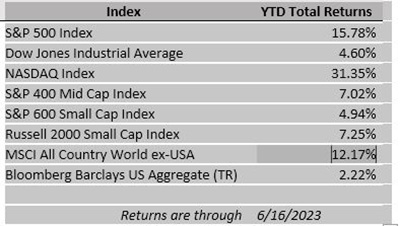Another positive week for the market as the S&P 500 closed up 2.6% for the fifth consecutive week of gains, Nasdaq up 3.3% for the eighth consecutive week, and Dow Jones up 1.3%. Federal Reserve officials agreed to hold interest rates steady last week for the first time since March 2022 after 10 consecutive increases, but signaled they were prepared to raise rates next month if the economy and inflation aren’t showing signs of slowing. New economic projections suggested officials were leaning toward slowing down their increases rather than stopping them altogether. During the press conference, Federal Reserve chair Powell suggested two more rate increases this year, which would lift rates to a 22-year high.
Americans opened their wallets more this spring in the latest sign of the economy’s surprising strength despite high interest rates and inflation. Consumers spent a seasonally adjusted 0.3% more in May at retail stores, restaurants and online, following April’s 0.4% advance, the Commerce Department said Thursday. That growth reflected robust hiring and rising wages that pumped up incomes in recent months, further defying recession predictions in early 2023.
Consumers spent more at grocery, furniture and electronics stores last month. They also appeared to shrug off higher interest rates in May. Sales climbed at auto dealerships and home-improvement stores, places where customers often borrow to pay for big-ticket purchases. That presents a challenge for the Federal Reserve, which has aggressively raised interest rates over the past year to combat inflation by cooling the economy.
The Consumer Price Index (CPI) rose 0.1% in May on a seasonally adjusted basis, after increasing 0.4% in April, the U.S. Bureau of Labor Statistics reported. Over the last 12 months, the all-items index increased 4.0% before seasonal adjustment. This was the smallest 12-month increase since March 2021. Core CPI (excluding food and energy) rose 5.3% over the last 12 months.
The index for shelter was the largest contributor to the monthly headline increase, followed by an increase in the index for used cars and trucks. The food index increased 0.2% in May after being unchanged in the previous 2 months and is up 6.7% over the last year. The index for food at home rose 0.1% over the month. The energy index, in contrast, declined 3.6% in May as the major energy component indexes fell. Energy prices are now down 11.7% over the last 12 months ending May.
U.S. producer prices fell more than expected in May as the costs of energy goods and food declined, signaling that inflation pressures were abating throughout the economy and could eventually provide relief to consumers. The Producer Price Index (PPI) declined 0.3% in May, seasonally adjusted, following a 0.2% increase in April, the U.S. Bureau of Labor Statistics reported. The report from the Labor Department also showed the annual increase in producer inflation last month was the smallest in nearly 2-1/2 years as year-over-year growth fell to just 1.2%.



